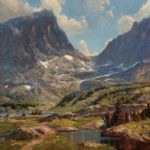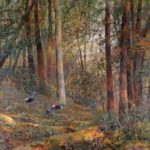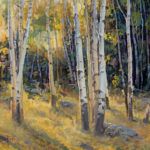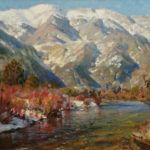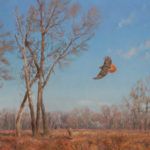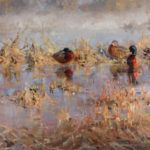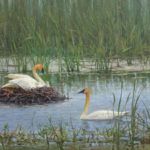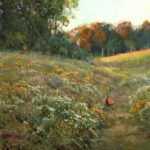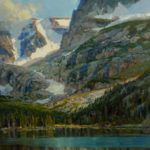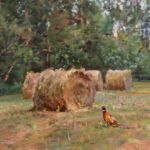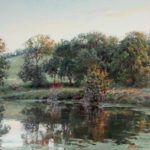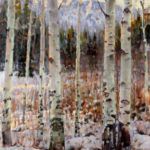Andrew Peters’ paintings communicate his reverence for wilderness and wild creatures
By Bonnie Gangelhoff
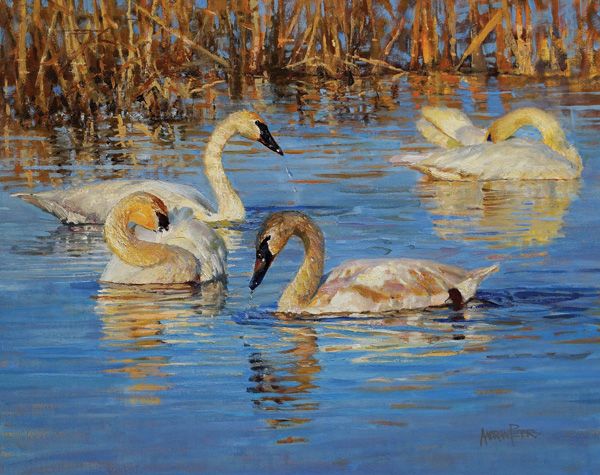
Andrew Peters, The Cygnet’s Reflection, oil, 26 x 32.
This story was featured in the June 2018 issue of Southwest Art magazine. Get the Southwest Art June 2018 print issue or digital download now–then subscribe to Southwest Art and never miss another story.
Andrew Peters recalls the exact moment he “hit the lottery,” as he puts it. He was 22 years old, three weeks away from college graduation, and sitting in the audience at the annual Iowa Duck Stamp competition in Des Moines. Peters watched as the judges scored the paintings in the contest one by one. Then came the grand finale—the announcement of the first-place winner. “As soon as my brother and friends heard my name, they started pounding me on my back and really whooping it up,” Peters says. “Older, established artists were there. But no one knew me.”
For the budding artist, the recognition was a game changer. Peters soon learned that he could expect to receive about $35,000 for several consecutive years from the print sales of his artwork, which depicted a trio of bufflehead ducks in flight. “That was a lot of money to a broke college kid,” he says.
Armed with a degree in wildlife biology and a minor in art from Iowa State University, but with no business experience, in 1979 Peters plunged the duck-stamp money into opening a gallery in Omaha, NE, and launching his fine-art career. The successful gallery was a showcase for his bird paintings and prints. Life seemed rather perfect, at least for a spell.
But one thing you need to know about Peters is that he is a seeker, an adventuresome soul who doesn’t mind living outside the box or inside a mobile studio RV named Nomad. Art and travel are intimately woven into the fabric of his life. So it comes as little surprise that, after just two years of owning the gallery, he sold it and set off on a yearlong solo painting expedition in Africa.
- Andrew Peters, Angel Pass, oil, 36 x 36.
- Andrew Peters, Hazel Dell Forest, oil, 30 x 36.
- Andrew Peters, Mountain Grouse Country, oil, 24 x 30.
The odyssey would inform his future philosophy of art in many ways. In the early part of the adventure, he viewed the dawn of each new day much like a sprawling blank canvas. Spontaneity ruled as he sketched, drew, and painted his way across the vast continent, visiting Tanzania, Zambia, and Zimbabwe. Alluring subject matter beckoned everywhere he looked. There were fertile deltas, arid deserts, elephants, giraffes, and zebras as well as the stunning Maasai people of Kenya. “You don’t always know your plans, but you have to reckon your way through it,” Peters says of the trip. “It’s a very daunting process, but I thought if I could make it for a year trekking around Africa without a net, I would be ready to face hundreds of blank canvases in the years ahead.”
The African experience was a harbinger of things to come. From the early 1980s through 2008, he was often on the road. Following his African painting safari, he journeyed overland through Mexico and Central America, eventually landing in Cusco, Peru. His mission: to portray the Quechua and Aymara people of the Sacred Valley of the Incas. “I wanted to view the indigenous people in their ancestral home, living a subsistence lifestyle and wearing traditional clothing,” he says.
Peters has also spent extended periods of time painting the Tuscan hills of Italy, farms in rural Romania, and an array of adobe structures in Morocco. From 2000 to 2008, the peripatetic artist set up bases of operations in the wild spaces of Colorado, Arizona, and Wyoming. “Finishing paintings from life, while on the move, takes you out of your comfort zone to a tough-love boot camp where you come out with good art,” Peters says.
Today Peters is comfortably ensconced in his current home in Council Bluffs, IA. At press time, he had just finished packing up a quartet of wildlife and landscape paintings to ship to Oklahoma City, OK, for this month’s prestigious Prix de West Invitational at the National Cowboy & Western Heritage Museum. One painting, WILDLAND NATIVITY, showcases Peters’ lifelong fascination with birds. The elegant work depicts three trumpeter swans—a mother and her chick nesting on a lake while a third floats nearby, appearing to guard his young family. Lush green grasses form the backdrop.
- Andrew Peters, South Fork Ogden River, oil, 26 x 32.
- Andrew Peters, Spring Hawk, oil, 24 x 30.
- Andrew Peters, Traveler’s Rest, oil, 24 x 30.
The piece is all the more intriguing when Peters discusses his personal connection to the subject matter. When he first saw trumpeter swans nesting, he was 14 years old and on vacation in Yellowstone National Park with his family. At the time the swans were a critically endangered species. Peters would not see them nesting again until decades later. “WILDLAND NATIVITY depicts the first successful nesting near my own home in 147 years,” Peters says. “Conservation biology engineered their comeback from near extinction. When I painted a pair of trumpeter swans in flight in Yellowstone at 14, it was a kind of prayer for their return.”
This kind of reverence for nature is a key element in Peters’ work, says Tom Bassett, who represents the artist at Wood River Fine Arts in Ketchum, ID. “As someone who has shared the same parallel experiences backpacking, backcountry skiing, and a life in the mountains, I relate to the images he creates,” Bassett says. “Nature is Andy’s church.”
Peters grew up in Council Bluffs as the son of an outdoorsman who hunted, fished, and hiked. Peters would eventually join his father in duck blinds and traipsing through windswept prairies and marshlands. His father often brought home brilliantly colored wildfowl from his trips. The striking plumage of the birds captivated Peters’ imagination when he was as young as 5 years old, and he still recalls his first attempts at drawing one of the winged creatures: “There was a gorgeous, iridescent blue rectangle on a mallard’s secondary feathers,” Peters says. “I knew as a young child I could draw a rectangle and color it blue. It was a powerful feeling and took my relationship to a new level. I felt connected to nature from that point on.”
When Peters was 10, his mother, recognizing his artistic ability, enrolled him in classes at the Joslyn Art Museum in Omaha, which sits across the Missouri River from Council Bluffs. In middle school, Peters continued to pursue art with private lessons from a local professional artist, Fran Day.
But the most significant influences by far on his burgeoning art career sprung from two deceased artists, John James Audubon [1785-1851] and Karl Bodmer [1809-1893]. As a youngster, Peters remembers his father bringing home Audubon’s prints depicting birds in their natural habitats. The images enthralled him and his three brothers, and they blanketed their bedroom walls with the artworks. “Audubon’s bird paintings are so profound and exquisitely drawn that once you see them, he owns you,” Peters says.
- Andrew Peters, Wildland Nativity, oil, 26 x 32.
- Andrew Peters, Courtship Season, oil, 20 x 24.
- Andrew Peters, Fern Lake Trail, oil, 30 x 36.
While studying art at the Joslyn, he also had the chance to see its collection of more than 400 works by Bodmer, who is known for his evocative depictions of the American West. But for Peters, it wasn’t just about the masterful works by these two legendary artists. He was equally drawn to their romantic, vagabond lifestyles—camping, canoeing, and capturing nature on location. “Both
Bodmer and Audubon roamed the wilderness and emerged with paintings,” Peters says. “They both made art outdoors, and I realized I, too, could make art on the move. I somehow perceived back then that the artist was, by definition, a loner and a seeker. Artists slept on cold mountains, went out in every season and in every kind of weather. That life had enormous appeal.”
Peters’ residence and studio are nestled in the middle of a serene nature preserve, a bluestem prairie surrounded by a forest of oaks. He moved back to his hometown 10 years ago.
North light streams into his studio from a window that illuminates the space. The window also reveals a wetlands area that Peters has restored to attract and protect wildlife. On a recent windy day in April, Peters says he counted 85 ducks and geese taking shelter on his property. Subject matter is a few steps from his front door, and with his painting gear and his German wirehaired pointers, Robin and Phoebe, in tow, it’s easy for him to disappear into the wild.
These days Peters is known for his luminous interpretations of the American West. With a painterly, impressionistic sensibility, he depicts mountain peaks at daybreak, snow-covered hay bales, and alpine rivers above timberline. Each artwork lures viewers into its scene, often a peaceful oasis where they want to linger for a while.
The Rocky Mountains, Zion National Park, and the Grand Tetons make regular appearances in Peters’ portfolio. And such works are held in the permanent collections of the National Cowboy & Western Heritage Museum as well as the National Museum of Wildlife Art in Jackson, WY. “I want my paintings to convey the beauty of the natural world around us,” Peters says. “I think some people don’t realize how lucky we are to be surrounded by plants and animals. The wilderness and wild creatures are crucial to our survival, and we need to be stewards of our environment.”
Peters claims he has become more of “a homebody” in recent years, although he still makes annual pack trips into Wyoming’s Wind River Mountains with fellow artist Tucker Smith. When asked about other future painting excursions, he pauses for a few seconds and then replies nonchalantly, “Oh, in August I’m teaching a plein-air workshop in Siberia.” The supposed “homebody” is not joking, and he adds, “It’s a delightful opportunity.”
representation
Howell Gallery, Oklahoma City, OK; Wood River Fine Arts, Ketchum, ID; www.artzline.com.
- Andrew Peters, Hay Meadow Sanctuary, oil, 16 x 20.
- Andrew Peters, Secluded Pond, Summer Evening, oil, 24 x 30.
- Andrew Peters, Winter Blush, oil, 24 x 20.
This story was featured in the June 2018 issue of Southwest Art magazine. Get the Southwest Art June 2018 print issue or digital download now–then subscribe to Southwest Art and never miss another story.
MORE RESOURCES FOR ART COLLECTORS & ENTHUSIASTS
• Subscribe to Southwest Art magazine
• Learn how to paint & how to draw with downloads, books, videos & more from North Light Shop
• Sign up for your Southwest Art email newsletter & download a FREE ebook






